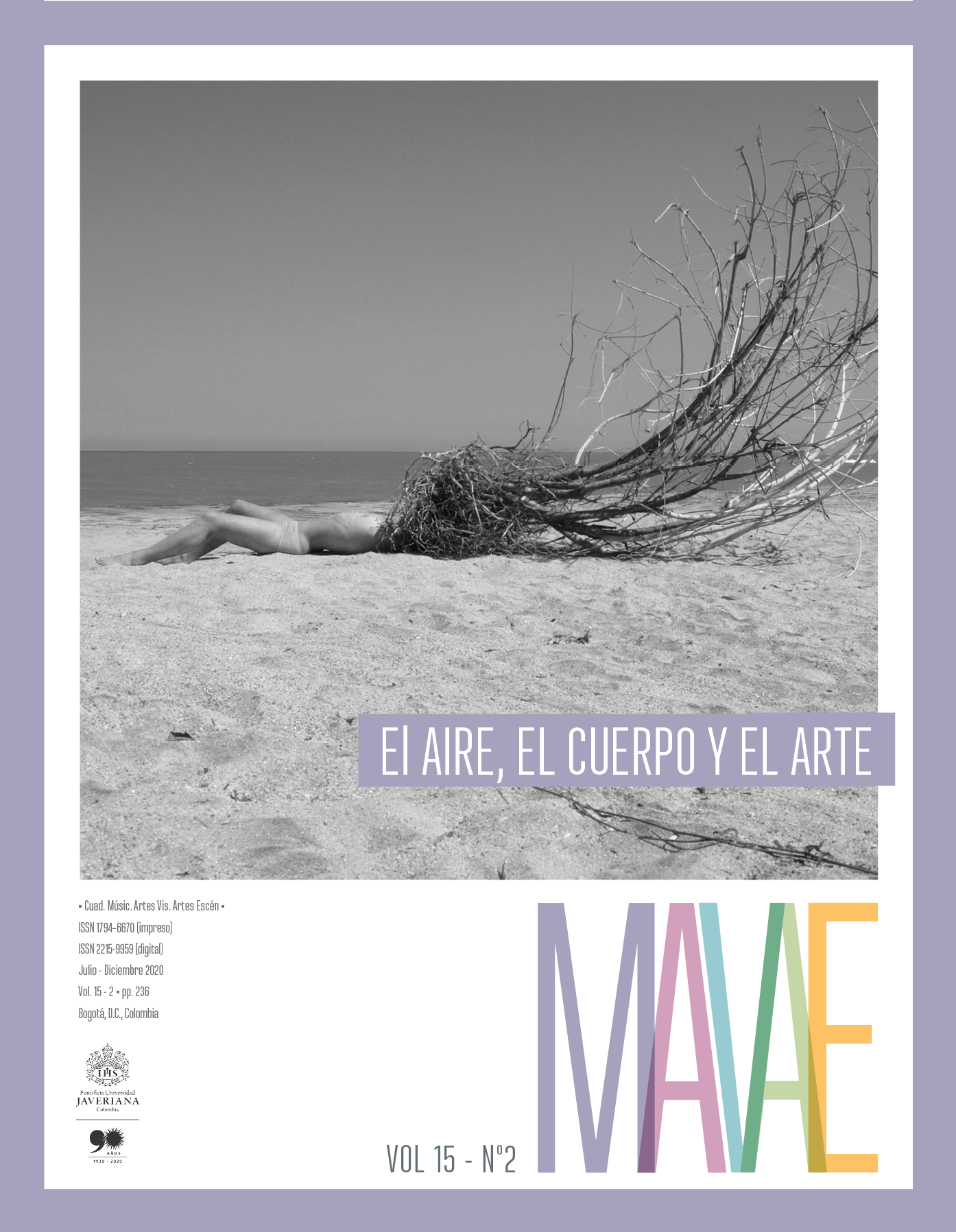Abstract
The article proposes an analysis of the presence of air in music and popular musical theatre in Uruguay, especially in the 1980s and 1990s. It is interesting to establish how the metaphors and allegories of the air meet the physical and symbolic water of the bay of Montevideo, a city that was the natural port par excellence of the South Atlantic during the Colonial period and that is still a meeting point of traditions. From Steven Connor’s proposal in Matter of Air (2010), the symbolic presence of air is addressed; elements of the anthropology of emotions and analysis from the rhetoric of the different types of art are integrated. The paper analyzes, in the case of songs, the lyrics and their relationship with music, especially those features linked to the literary content (characteristics of the vocal emission, instrumentation and arrangements), and, in the case of the murga, a genre of carnival musical theater, the link between literature, music, choreography, costumes, scenery and makeup. A more in-depth analysis is made for the show El planeador de la escollera Sarandí, produced by the murga, Curtidores de hongos, during the 2005 carnival of Montevideo, in which literary text and costumes complement each other in the production of meaning, and for two songs performed by Eduardo Darnauchans, a relevant figure of Uruguayan popular music. Also included is a brief presentation of other songs that metaphorically elaborate the visual and sound landscape of the city, with air as the thematic center.
Alfaro, Milita. 2012. Curtidores de hongos: Misteriosa leyenda.
Montevideo: Museo del Carnaval.
Alfaro, Milita. 2017. Jaime Roos, el montevideano. Montevideo: Planeta.
Appadurai, Arjun. 2001. La modernidad desbordada: Dimensiones
culturales de la globalización. Montevideo: Trilce.
Baskins, Cristelle y Lisa Rosenthal, eds. 2007. Early Modern Visual
Allegory: Emboding Meaning. Aldershot: Ashgate.
Beatty, Andrew. 2013. “Current Emotion Research in Anthropology:
Reporting the Field”. Emotion Review 5 (4);414 . 422.
Brown, Jane K. 2006. The Persistence of Allegory: Drama and
Neoclasicism from Shakespeare to Wagner. Philadelphia:
University of Pensylvannia Press.
Caldas Cervinskis, André y Wilma Martis de Mendonça. 2008.
“Religiosidade e brasilidade em Manuel Bandeira”. Prolingua 2
(2): 72-79. https://periodicos.ufpb.br/ojs2/index.php/prolingua/
article/view/13405/7609
Connor, Steven. 2010. The Matter of Air: Science and Art of the Ethereal.
Londres: Reaktion Books.
Couto, Tabaré. 1993. Eduardo Darnauchans: Los espejos y los mitos.
Montevideo: Arca.
DeNora, Tia. 2000. Music in Everyday Life. Oxford: Clarendon Press.
Díaz, Nelson. 2008. Memorias de un trovador: Conversaciones con
Darnauchans. Montevideo: Planeta.
Favoretto, Mara. 2014. Charly en el país de las alegorías: Un viaje por
las letras de Charly García. Buenos Aires: Gourmet Musical.
Feld, Steven. 1982. Sound and Sentiment Birds, Weeping, Poetics, and
Song in Kaluli Expression. Durham: Duke University Press.
Finnegann, Ruth. 2003. “Music, Experience, and the Anthropology
of Emotion”. En The Cultural Study of Music: An Introduction,
editado por Martin Clayton, Trevor Herbert y Richard Middleton,
181-192. Londres: Routledge.
Fletcher, Angus. 2002. Alegoría: Teoría de un modo simbólico.
Madrid: Akal.
Fornaro Bordolli, Marita. 1999. “‘Los cantos inmigrantes se mezclaron…’:
La murga uruguaya: Encuentro de orígenes y lenguajes”. El
Sonido de la Cultura: Textos de Antropología de la Música 15-16,
139-170. https://www.redalyc.org/pdf/822/82200607.pdf
Fornaro Bordolli, Marita. 2007. “Repertorios en la murga hispanouruguaya:
Del letrista a la academia”. Pandora: Revue d’etudes
hispaniques 7: 31-48.
Fornaro Bordolli, Marita. 2008. “Las quemas: Entre el agua y el
humo, la misma sed”. En Las quemas de Eduardo Darnauchans.
Montevideo: Sondor. CD-ROM.
Fornaro Bordolli, Marita. 2009. “Eduardo Darnauchans: El estar siempre”. En
Sansueña edición 30 años. Montevideo: Sondor. CD-ROM.
Fornaro Bordolli, Marita. 2013. “Voz, música, performance: El caso de
Eduardo Darnauchans en la música popular uruguaya”. Revista del
Instituto de Investigación Musicológica Carlos Vega 27: 121-150.
Fornaro Bordolli, Marita. 2017. “Más allá del humor: Articulación de
lenguajes artísticos y procedimientos retóricos en la murga hispanouruguaya”.
Tesis de doctorado, Universidad de Valladolid.
Fornaro Bordolli, Marita. 2018. “The Uruguayan Carnival Stages of the
First Half of the Twentieth Century between Transgression and
‘Measured Joy’”. Music in Art International Journal for Music
Iconography 43 (1-2): 123-140.
Fornaro Bordolli, Marita. 2019. “En la puerta giratoria: La visibilidad de Jorge
Drexler en la prensa española”. Cuadernos de Etnomusicología 13:
184-216. http://www.sibetrans.com/etno/cuaderno/31/cuadernosde-
etnomusicologia-n-13
Granizo. 2019. “Una canción a Montevideo” cumplió 25 años. Consultado:
17 de octubre de 2019. http://granizo.uy/medio-y-medios/unacancion-
a-montevideo-cumplio-25-anos/
Hesmondhalgh, David. 2008. “Towards a Critical Understanding of Music,
Emotion and Self-Identity”. Consumption, Market & Culture 11
(4): 329-343.
Honig, Edwin, 1959. Dark Conceit: The Making of Allegory. Míchigan:
Northwestern University Press.
Le Breton, David. 2013. “Por una antropología de las emociones”. Revista
Latinoamericana de Estudios sobre Cuerpos, Emociones y Sociedad
4 (10): 69-79.
Rodríguez, Marcelo. 2012. Darnauchans: Entre el cuervo y el ángel.
Montevideo: Perro Andaluz Ediciones.
Sabaj, Silvia. 2017. Darnauchans: Poesía y compromiso de un cantor popular
uruguayo. Montevideo: Ediciones del Empedrado.

This work is licensed under a Creative Commons Attribution 4.0 International License.
Copyright (c) 2020 Marita Fornaro Bordolli



